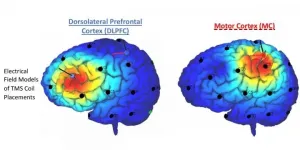New treatment location challenges thoughts on addiction
MUSC researchers prove motor cortex is successful target for pain and addiction treatment, which suggests an overlooked area of the brain in TMS treatment
2021-02-25
(Press-News.org) Researchers have discovered that there may be a new pathway in the brain that provides pain relief and reduces cravings for opioids.
Over a third of the U.S. population suffers from chronic pain, with little to no reported relief from medication. Transcranial magnetic brain stimulation (TMS) is a noninvasive form of brain stimulation that may offer a new treatment option for these underserved members of our community.
In a recent paper in Drug and Alcohol Dependence, researchers at the Medical University of South Carolina evaluated two different strategies for relieving pain with TMS: applying TMS to the motor cortex and the dorsolateral prefrontal cortex (DLPFC).
Colleen Hanlon, Ph.D., a professor in the department of psychiatry and behavioral sciences at MUSC and the principal investigator for this paper, expected to support her hypothesis that the DLPFC would be the most effective target for TMS treatment, but the results show just the opposite.
Historically, TMS-based treatments have targeted the DLPFC. In addition to being an FDA-approved target for managing depression, data show that the DLPFC is important in regulating emotions as well as addiction to substances like tobacco, cocaine and alcohol. While the motor cortex has been a popular target for TMS pain relief studies, there was no data to suggest it could also be helpful in opiate users. The new study points to its success as a target.
"I think you can even argue that our data suggests the motor cortex is an overlooked brain region in terms of addiction treatment development," said Julia Imperatore, MUSC research coordinator and lab manager for this study. Hanlon agrees.
Each study participant's head was mapped with coordinates to target specific areas of the brain using a swim cap marked with a permanent marker. Head circumferences differ between individuals, and thus so do the locations of the motor cortex and DLPFC. The motor cortex is located near the middle of the skull, and the DLPFC is closer to the front. Once these locations are determined, an electromagnetic coil is placed against the head, and magnetic pulses are painlessly and noninvasively sent through the skull to stimulate nerve cells in the brain.
After two weeks of administering daily TMS sessions and daily pain and opiate urge assessments, Hanlon's research team reported a significant difference in effects between the two locations. The motor cortex was significantly more effective at reducing the urge to use opioids and the study participant's perception of pain both immediately after treatment and during follow-up assessments. Direct magnetic stimulation to the motor cortex led to a 64-70% reduction in pain.
"This is the first study to evaluate a noninvasive therapeutic treatment to help decrease opiate use in chronic pain patients," said Hanlon. "We have no non-pharmacologic-based treatment options for people, and people are really tired of taking pills."
As a pilot study, Hanlon and Imperatore's paper kicks off a new area of research. It represents the first attempt at a randomized comparison of these two potential treatment targets, and it excites Hanlon because it suggests that the motor cortex is an important and influential part of the addiction process.
"Not only pain but also the urge to use, in this case, opiates," she said. "It's a whole new window of opportunity that we can explore."
Imperatore will be leading future studies to expand the knowledge on this topic, as this pilot study used a small sample size. MUSC will be conducting studies alongside Wake Forest School of Medicine and hopes to offer this new therapeutic option to patients suffering from chronic pain and addiction in the near future.
INFORMATION:
[Attachments] See images for this press release:

ELSE PRESS RELEASES FROM THIS DATE:
2021-02-25
When birds see a predator in their midst, one defensive strategy is to call out loudly, attracting other birds of the same or different species to do the same. Sometimes individuals within this "mobbing flock" will fly over or at the predator or attack it directly. Now, researchers reporting in the journal Current Biology on February 25 have found that male superb lyrebirds do something rather unexpected: they imitate a mobbing flock in courtship and even in the act of mating with a female.
"Our paper shows that male superb lyrebirds regularly create a remarkable acoustic illusion of a flock of mobbing birds ...
2021-02-25
Researchers at the Garvan Institute of Medical Research have discovered a new type of bone cell that may reveal new therapeutic approaches for osteoporosis and other skeletal diseases.
The new cells, which the researchers term 'osteomorphs', are found in the blood and bone marrow, and fuse together to form osteoclasts, specialised cells that break down bone tissue. They have a unique genomic profile that reveals promising and as yet unexplored targets for therapy.
"This discovery is a game-changer, which not only helps us understand bone biology but presents significant new in-roads for osteoporosis therapy," says co-senior ...
2021-02-25
A 20% shift in beverage sales from small to medium-sized plastic bottles could reduce the production of polyethylene terephthalate (PET) waste in the USA by over 9,000 tonnes annually, a study in Scientific Reports suggests.
PET is the dominant material used in plastic bottles containing non-alcoholic beverages. Rafael Becerril-Arreola and Randolph Bucklin weighed 187 differently sized PET bottles sold by the best-selling beverage brands in Minnesota, USA, to identify which bottles sizes were the most efficient at delivering the highest volume of beverage for the lowest packaging weight. To validate their findings, the researchers combined data on sales of different sized PET bottles ...
2021-02-25
Researchers at the University of California, Berkeley, have found a new way to harness properties of light waves that can radically increase the amount of data they carry. They demonstrated the emission of discrete twisting laser beams from antennas made up of concentric rings roughly equal to the diameter of a human hair, small enough to be placed on computer chips.
The new work, reported in a paper published Thursday, Feb. 25, in the journal Nature Physics, throws wide open the amount of information that can be multiplexed, or simultaneously transmitted, by a coherent light source. A common example of multiplexing is the transmission of multiple telephone calls ...
2021-02-25
Never before in over 1000 years the Atlantic Meridional Overturning Circulation (AMOC), also known as Gulf Stream System, has been as weak as in the last decades. This is the result of a new study by scientists from Ireland, Britain and Germany. The researchers compiled so-called proxy data, taken mainly from natural archives like ocean sediments or ice cores, reaching back many hundreds of years to reconstruct the flow history of the AMOC. They found consistent evidence that its slowdown in the 20th century is unprecedented in the past millennium; it is likely linked to human-caused climate change. The giant ocean circulation is relevant for weather patterns ...
2021-02-25
More intense and frequent fires are reducing the size of tree communities in many regions of the world.
Slower-growing tree species are better at surviving fires, but these may capture less atmospheric carbon and reduce nutrient availability in the soil.
Not all regions are suitable for planting trees to tackle climate change; schemes must consider local wildfire frequency, vegetation cover and climate, and how these might change over time.
Researchers have analysed decades' worth of data on the impact of repeated fires on ecosystems across the world. Their results, published today in the journal Nature Ecology and Evolution, show that repeated fires are driving long-term changes to tree communities and reducing their population ...
2021-02-25
Until recently, scientists believed that the primary cilium - an antenna-like structure found on the surface of most human cells - was largely vestigial and had little bearing on the day-to-day lives of human beings. But more recently, a relatively small number of people have been found to have rare genetic disorders affecting the cilium, characterized by a number of health problems, including common conditions like diabetes, kidney failure, and liver fibrosis. Now, an analysis of genes involved in the function of the cilium found that the same genes causing its rare diseases might ...
2021-02-25
What The Study Did: Researchers in this observational study of more than 10,000 U.S. Air Force basic trainees examined whether symptoms and laboratory results on the first day of COVID-19 diagnosis are associated with development of a case cluster in a congregate setting.
Authors: Joseph E. Marcus, M.D., of the Brooke Army Medical Center at Joint Base San Antonio Fort Sam Houston, Texas, is the corresponding author.
To access the embargoed study: Visit our For The Media website at this link https://media.jamanetwork.com/
(doi:10.1001/jamanetworkopen.2021.0202)
Editor's Note: Please see the article for additional information, including other authors, author contributions and affiliations, conflict of interest and financial disclosures, and funding ...
2021-02-25
What The Study Did: This research letter describes the various otolaryngologic manifestations in patients 18 years or younger with pediatric inflammatory multisystem syndrome temporally associated with SARS-CoV-2.
Authors: Ryan C. T. Cheong, B.Sc.(Hons), M.B.B.S., of the Great Ormond Street Hospital for Children NHS Trust in London, United Kingdom, is the corresponding author.
To access the embargoed study: Visit our For The Media website at this link https://media.jamanetwork.com/
(doi:10.1001/jamaoto.2020.5698)
Editor's Note: The article includes conflict of interest and funding/support disclosures. Please see the article for additional information, including other authors, author contributions and affiliations, conflict of interest ...
2021-02-25
What The Study Did: Data from five studies were pooled to investigate whether cognitive decline among older U.S. adults varied by sex.
Authors: Deborah A. Levine, M.D., M.P.H., of the University of Michigan in Ann Arbor, is the corresponding author.
To access the embargoed study: Visit our For The Media website at this link https://media.jamanetwork.com/
(doi:10.1001/jamanetworkopen.2021.0169)
Editor's Note: The article includes conflicts of interest and funding/support disclosures. Please see the article for additional information, including other authors, author contributions and affiliations, conflict of interest and financial ...
LAST 30 PRESS RELEASES:
[Press-News.org] New treatment location challenges thoughts on addiction
MUSC researchers prove motor cortex is successful target for pain and addiction treatment, which suggests an overlooked area of the brain in TMS treatment


